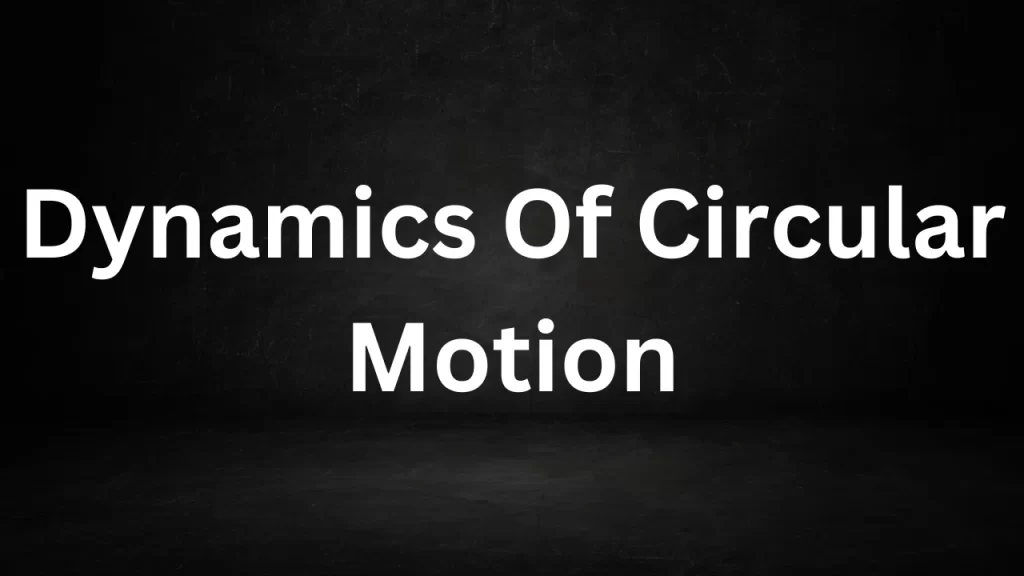Dynamics Of Circular Motion: Circular motion, characterized by the continuous movement of an object along the circumference of a circle, is a ubiquitous phenomenon in our daily lives.
From the Earth revolving around the Sun to the spinning wheels of a car, circular motion is governed by a set of fundamental principles that involve forces, acceleration, and velocity. In this article, we delve into the dynamics of circular motion, shedding light on the key concepts that drive objects in circular paths.

Dynamics Of Circular Motion
The Basics of Circular Motion
Before delving into the dynamics, it’s important to understand the basic elements of circular motion:
- Centripetal Force: Circular motion requires a force directed toward the center of the circle, known as the centripetal force. This force keeps the object moving in a curved path and prevents it from moving in a straight line (according to Newton’s First Law).
- Tangential Velocity: Objects in circular motion have a tangential velocity, which is the velocity along the tangent to the circle at any given point. This velocity is always changing in magnitude because the direction of motion is constantly changing.
- Angular Velocity: Angular velocity measures the rate of change of angular displacement with respect to time. It is usually denoted by the Greek letter ω (omega) and is measured in radians per second (rad/s).
The Centripetal Force: A Fundamental Component
- The centripetal force is central to understanding the dynamics of circular motion. Its magnitude depends on the mass of the object in motion (m), the radius of the circular path (r), and the object’s tangential velocity (v). Mathematically, it can be expressed as:
- F_c = (mv^2) / r
Where:
- F_c represents the centripetal force.
- m is the mass of the object.
- v is the tangential velocity of the object.
- r is the radius of the circular path.
- Newton’s Second Law and Circular Motion
- Applying Newton’s second law to circular motion, we find that the net force acting on an object moving in a circle is equal to the mass of the object times its centripetal acceleration (a_c):
- ΣF = ma_c
- Since acceleration is the change in velocity over time, we can express the centripetal acceleration as:
- a_c = (Δv) / Δt
- In circular motion, the direction of velocity is constantly changing, which means there is an acceleration even if the speed remains constant. This acceleration is directed towards the center of the circle, in line with the centripetal force.
Banked Curves and Non-Uniform Circular Motion
- In some cases, circular motion involves banked curves, as seen in race tracks and highways. Banked curves are designed to allow vehicles to move safely around corners at high speeds. The angle of banking and the speed of the vehicle are crucial factors in these scenarios.
- Additionally, not all circular motion is uniform, where the object travels at a constant speed. Non-uniform circular motion involves changing speed, which requires a varying centripetal force.
Real-World Applications
- Understanding the dynamics of circular motion has far-reaching applications:
- Orbital Mechanics: The motion of planets, satellites, and celestial bodies in orbit is governed by circular motion principles.
- Automotive Engineering: Understanding circular motion is essential for designing safe and efficient roadways and racetracks.
- Amusement Rides: Roller coasters, carousels, and other amusement park rides rely on circular motion dynamics to create thrilling experiences.
- Sports: Concepts of circular motion are integral in sports such as racing, figure skating, and gymnastics.
In conclusion, the dynamics of circular motion are a fundamental part of physics and have numerous practical applications. Whether it’s the Earth’s rotation around the Sun or the dynamics of a spinning top, the principles of circular motion help us comprehend the world around us and engineer solutions for a wide range of challenges.
Read More
- Molecular Weight Of Acetic Acid
- Difference Between Torque And Power
- Difference Between Emission And Absorption Spectra
- Ionic Product Of Water
- Hunds Rule Of Maximum Multiplicity
Frequently Asked Questions (FAQs) Dynamics Of Circular Motion
1. What is circular motion, and how does it differ from linear motion?
Circular Motion: Circular motion is the continuous movement of an object along the circumference of a circle or a curved path. In circular motion, the object’s direction changes at every point along the path.
Linear Motion: Linear motion is the movement of an object along a straight line, where its speed and direction remain constant.
2. What is centripetal force, and why is it necessary for circular motion?
Centripetal force is a force that acts on an object moving in a circular path, directing it toward the center of the circle. It is essential for circular motion because it keeps the object from moving in a straight line and ensures it follows the curved path.
3. How is centripetal force related to circular motion dynamics?
Centripetal force is the force responsible for maintaining an object’s circular motion. It is crucial for keeping the object on its curved path, as it continuously changes the object’s direction toward the center of the circle.
4. What determines the magnitude of the centripetal force in circular motion?
The magnitude of the centripetal force depends on several factors, including the mass of the object (m), the tangential velocity of the object (v), and the radius of the circular path (r). The formula for centripetal force is F_c = (mv^2) / r.
5. How does the velocity of an object change in circular motion?
In circular motion, the velocity of an object is not constant because its direction is continually changing. While the object may travel at a constant speed, its velocity vector keeps rotating with the motion, leading to acceleration.
